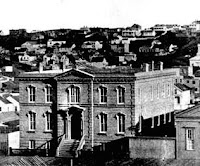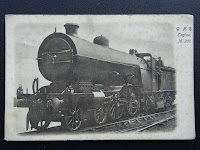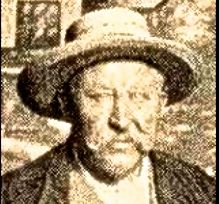The Tragic Passion of J.W. Cornell
The letterhead above for James W. Cornell, introduces a successful saloonkeeper and liquor dealer of Cascade, Montana, whose unrequited love for a “soiled dove” at a brothel in nearby Butte led to a tragic end for the principals and shattered lives for others involved.
Born in 1864 in Susanville, California, a town close to the Nevada border, James was the son of Harriet Maston and Heriro Keneda Cornell. Know as “Iro,” James’ father presumably was of mixed Japanese parentage, born in New York. Iro was a farmer and for one period postmaster of Clear Lake, California. Mother Harriet had come from Ohio. The couple produced a family of six children in ten years, one of whom died in infancy. James was the third in line. He presumably was given the standard education of the times, ending about the age of 16.
Cornell first shows up in records in 1888 when at the age of 24, he registered to vote in California, giving his address as Tulelake and his occupation as “farmer.” His younger brother Clarence registered with him. The brothers likely were engaged in spring wheat production, a prominent crop in the northern part of the state. Meanwhile Margaret Goldstein, later to be known as “Goldie Graham,” was born elsewhere in California of unknown parentage, possibly of an unwed mother.
It is unclear when Cornell showed up in Montana and opened his saloon in the town of Cascade, shown above, apparently during the early 1890s. He may have decided there was more profit in selling wheat in liquid form than in farming it. Situated on the north bank of the Missouri River, Cascade had been founded in the 1880s by Pioneer Thomas Graham. Located in Cascade County downriver from Butte, the town was linked to the outside world by the Great Northern Railroad. Cascade served a region boasting 250,000 sheep, 75,000 head of cattle and 50,000 horses, as well as several hundred people. In 1897 the town was described as having a school, two churches, two blacksmith shops, two hotels and a livery stable. There was no mention of drinking establishments.
 Cornell apparently was a success as a saloonkeeper. A strong indication was his being selected as the agent for “Gold Bond Whiskey” by Isaac Solomon & Co. This was a well established Cincinnati liquor house with a branch in New York City. Solomon provided Cornell with stationary for his letterhead and advertising shot glasses with which to gift special customers. Those contributions attest to confidence in the saloonkeeper.
Cornell apparently was a success as a saloonkeeper. A strong indication was his being selected as the agent for “Gold Bond Whiskey” by Isaac Solomon & Co. This was a well established Cincinnati liquor house with a branch in New York City. Solomon provided Cornell with stationary for his letterhead and advertising shot glasses with which to gift special customers. Those contributions attest to confidence in the saloonkeeper.
A bachelor until he was 27 Cornell eventually found a bride in Cascade County. She was Mary Loss Conlin, born in Fort Dodge, Kansas, the daughter of Robert T. Loss, a prominent Cascade citizen. The same age as James, Mary apparently had a previous marriage. The Cornells were wed in 1893 in the nearby hamlet of Sun River. There is no record of any children.
 By 1893 Margaret Goldstein, an orphan, had reached six years old and was in San Francisco. She likely was living at the Mount St. Joseph Infant Asylum run by the Catholic Sisters of Charity of St. Vincent de DePaul. Shown here are the home’s 108 young orphan girls in their uniforms. As Margaret grew and went unadopted, she was transferred to San Francisco’s Roman Catholic Orphan’s Society at 18th Avenue and N Street North. The 1900 Federal Census found her there, now 12 years old. Like all the older girls Margaret had to have an occupation and was recorded working as a laundress.
By 1893 Margaret Goldstein, an orphan, had reached six years old and was in San Francisco. She likely was living at the Mount St. Joseph Infant Asylum run by the Catholic Sisters of Charity of St. Vincent de DePaul. Shown here are the home’s 108 young orphan girls in their uniforms. As Margaret grew and went unadopted, she was transferred to San Francisco’s Roman Catholic Orphan’s Society at 18th Avenue and N Street North. The 1900 Federal Census found her there, now 12 years old. Like all the older girls Margaret had to have an occupation and was recorded working as a laundress.
 During the ensuing years Margaret’s path led her from California and to a way of life the nuns would not have wished for her. At about 20, without benefit of matrimony, she gave birth to a daughter and gravitated to Great Falls, Montana. This was a city on the Missouri River where numerous “soiled doves” of prostitution plied their occupation. Shown here is a typical house in a “red light” district. Margaret found residence in a brothel run by a woman named Myra Collins. There she changed her name to Goldie Graham. My imagination sees her looking like the woman below, still youthful and attractive.
During the ensuing years Margaret’s path led her from California and to a way of life the nuns would not have wished for her. At about 20, without benefit of matrimony, she gave birth to a daughter and gravitated to Great Falls, Montana. This was a city on the Missouri River where numerous “soiled doves” of prostitution plied their occupation. Shown here is a typical house in a “red light” district. Margaret found residence in a brothel run by a woman named Myra Collins. There she changed her name to Goldie Graham. My imagination sees her looking like the woman below, still youthful and attractive.
 It was at Myra Collins’ house that Cornell, now 45 years old and 17 years married, found Goldie Graham and became totally enamored of her. Their relationship over time apparently became strained as he might have seen her transfer her affections elsewhere. He began to drink heavily and when drunk was known to threaten Goldie. On the night of July 16, 1911, according to theGreat Falls Leader, Cornell, now estranged from wife Mary, closed his saloon and mounting the Great Northern train in Cascade arrived in Great Falls about 10 p.m. Bystanders said he appeared to be sober.
It was at Myra Collins’ house that Cornell, now 45 years old and 17 years married, found Goldie Graham and became totally enamored of her. Their relationship over time apparently became strained as he might have seen her transfer her affections elsewhere. He began to drink heavily and when drunk was known to threaten Goldie. On the night of July 16, 1911, according to theGreat Falls Leader, Cornell, now estranged from wife Mary, closed his saloon and mounting the Great Northern train in Cascade arrived in Great Falls about 10 p.m. Bystanders said he appeared to be sober.
 Cornell made straight for Myra Collins’ brothel at 217&1/2 Rosebud Alley and accosted Goldie who was a front room with other women. According to witnesses they argued. He stood up, took a 44. caliber pistol from his pocket, looked at Goldie, and shouted: “I’ve been going to do this for a long time and now I’ll finish it.” Madam Collins told the press that she tried to hustle Goldie out of the room when she sensed trouble, but the young woman was slow to heed the warning.
Cornell made straight for Myra Collins’ brothel at 217&1/2 Rosebud Alley and accosted Goldie who was a front room with other women. According to witnesses they argued. He stood up, took a 44. caliber pistol from his pocket, looked at Goldie, and shouted: “I’ve been going to do this for a long time and now I’ll finish it.” Madam Collins told the press that she tried to hustle Goldie out of the room when she sensed trouble, but the young woman was slow to heed the warning.
At last sensing the danger, Goldie tried to run out a back door. Said the newspaper: “Cornell was too quick for her and shot her in the side. The bullet entered the left side well toward the base of the lungs, passed entirely through her body, coming out the right side, tore a hole in her right arm and lodged in the wall.” Then the saloonkeeper raised the pistol one more time, pointed it at his head and blew his brains out. His passion and fury spent, James Cornell lay in a pool of blood, dead on the brothel floor.
 Meanwhile, Goldie, badly wounded, staggered into the back yard where she was assisted by another prostitute who caught her as she fell. The friend beat out a fire on her dress that had been ignited by the powder flash and carried her to a bed. Police and a doctor were called. Dr. Leroy Southmayd, assessing the situation, said that it was not possible to make a final diagnosis of Goldie’s condition but, the press said, “…He believed she would get well.” The young woman was rushed to Butte’s Deaconess Hospital, shown here, where she lingered in pain for a week before dying. Her death certificate listed the cause as “gun shot wound of lungs” and labeled it a homicide. Possibly noting the existence of her daughter, the certificate pronounced Goldie “widowed.”
Meanwhile, Goldie, badly wounded, staggered into the back yard where she was assisted by another prostitute who caught her as she fell. The friend beat out a fire on her dress that had been ignited by the powder flash and carried her to a bed. Police and a doctor were called. Dr. Leroy Southmayd, assessing the situation, said that it was not possible to make a final diagnosis of Goldie’s condition but, the press said, “…He believed she would get well.” The young woman was rushed to Butte’s Deaconess Hospital, shown here, where she lingered in pain for a week before dying. Her death certificate listed the cause as “gun shot wound of lungs” and labeled it a homicide. Possibly noting the existence of her daughter, the certificate pronounced Goldie “widowed.”
When the news got back to Cascade, Cornell’s pistol assault and suicide caused considerable stir and speculation. The saloonkeeper was a familiar figure in town, even if his passion for Goldie was not generally known. Mary Cornell arrived in Great Falls the next morning to take possession of James’ body and a gold watch and diamond ring found in his pocket. Had Cornell once meant the ring for Goldie?
 While the Fraternal Order of Eagles, of which Cornell was a member, arranged for the saloonkeepers funeral, Myra Collins saw to Goldie’s. Arrangements were handled by the same funeral director. The tragic pair both were buried in Great Falls’ Highland Cemetery. James Cornell’s gravestone, shown here, proclaims him “At Rest.” Goldie’s grave apparently has gone unmarked. The saloon was shut.
While the Fraternal Order of Eagles, of which Cornell was a member, arranged for the saloonkeepers funeral, Myra Collins saw to Goldie’s. Arrangements were handled by the same funeral director. The tragic pair both were buried in Great Falls’ Highland Cemetery. James Cornell’s gravestone, shown here, proclaims him “At Rest.” Goldie’s grave apparently has gone unmarked. The saloon was shut.
 In reflecting on these events, I feel particular pity for Margaret/Goldie caught up in these deadly events. It reminds me of a quote from the biologist Steven J. Gould: “We pass through this world but once. Few tragedies can be more extensive than the stunting of life, few injustices deeper than the denial of an opportunity to strive or even to hope, by a limit imposed from without….”Goldie’s daughter, now herself an orphan, was sent to live with a relative in Boise, Idaho.
In reflecting on these events, I feel particular pity for Margaret/Goldie caught up in these deadly events. It reminds me of a quote from the biologist Steven J. Gould: “We pass through this world but once. Few tragedies can be more extensive than the stunting of life, few injustices deeper than the denial of an opportunity to strive or even to hope, by a limit imposed from without….”Goldie’s daughter, now herself an orphan, was sent to live with a relative in Boise, Idaho.
Notes: This post has been drawn from a variety of sources. The letterhead that opens this narrative put me on the trail of James Cornell and articles from theGreat Falls Tribune and The Great Falls Leader provided the gist of the story. My plumbing of genealogical sources led me to the early life of Goldie Graham as well as information on other principals in these tragic events








Comments
Post a Comment